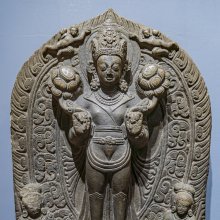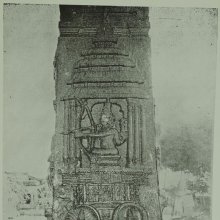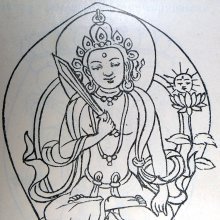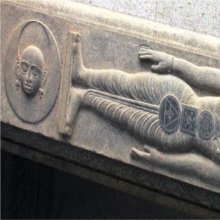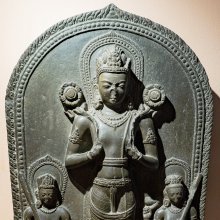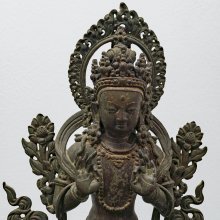Shun, Sun, Śun: 12 definitions
Introduction:
Shun means something in Hinduism, Sanskrit, the history of ancient India, biology. If you want to know the exact meaning, history, etymology or English translation of this term then check out the descriptions on this page. Add your comment or reference to a book if you want to contribute to this summary article.
The Sanskrit term Śun can be transliterated into English as Sun or Shun, using the IAST transliteration scheme (?).
Images (photo gallery)
(+39 more images available)
In Hinduism
Natyashastra (theatrics and dramaturgy)
Source: Shodhganga: Elements of Art and Architecture in the Trtiyakhanda of the Visnudharmottarapurana (natya)The Sun is associated with Sūcyāsyahasta: one of the twenty-two Single-hand Gestures (in Indian Dramas) (known as asaṃyuktahastas), according to the Viṣṇudharmottarapurāṇa, an ancient Sanskrit text which (being encyclopedic in nature) deals with a variety of cultural topics such as arts, architecture, music, grammar and astronomy.—The word sūcī means a tool which is used for stitching. It refers to the needle. [...] In the Abhinayadarpaṇa, numbers like one and hundred are shown with the sūcyāsya-hasta posture. Paramabrahma i.e., the Supreme Entity is also indicated with this hand posture. Moreover, this hand posture also indicates the sun and a city.

Natyashastra (नाट्यशास्त्र, nāṭyaśāstra) refers to both the ancient Indian tradition (shastra) of performing arts, (natya—theatrics, drama, dance, music), as well as the name of a Sanskrit work dealing with these subjects. It also teaches the rules for composing Dramatic plays (nataka), construction and performance of Theater, and Poetic works (kavya).
Shilpashastra (iconography)
Source: Shodhganga: Elements of Art and Architecture in the Trtiyakhanda of the Visnudharmottarapurana (shilpa)The Sun refers to class of natural objects and phenomenon which follows specific guidelines in the tradition of ancient Indian Painting (citra), according to the Viṣṇudharmottarapurāṇa, an ancient Sanskrit text which (being encyclopedic in nature) deals with a variety of cultural topics such as arts, architecture, music, grammar and astronomy.—The Viṣṇudharmottarapurāṇa bears an elaborate description on the process of making the picture of some natural objects and phenomenon, e.g., the Sun. Accordingly, the time of Uṣā i.e., dawn when the sun is about to rise. It seems to be a beautiful source of Painting. In the Viṣṇudharmottarapurāṇa, the picture of this time is associated with the rising of the sun, dim lamps and cocks in crying mood. In the Vedic period, some natural objects and phenomena were associated with the form of deities. The time of dawn is also portrayed as the Goddess Uṣā in the Ṛgveda and it is said that, in the beginning of the day, the mighty Sun sends goddess Uṣā and after that the Sun god enters into the earth and heaven

Shilpashastra (शिल्पशास्त्र, śilpaśāstra) represents the ancient Indian science (shastra) of creative arts (shilpa) such as sculpture, iconography and painting. Closely related to Vastushastra (architecture), they often share the same literature.
Yoga (school of philosophy)
Source: ORA: Amanaska (king of all yogas): A Critical Edition and Annotated Translation by Jason BirchThe Sun can be denoted by the Sanskrit term Sūrya, according to the Amanaska Yoga treatise dealing with meditation, absorption, yogic powers and liberation.—Accordingly, as Īśvara says to Vāmadeva: “[...] [Now], I shall define the nature of that highest, mind-free absorption which arises for those devoted to constant practice. [...] By means of an absorption for half a day, the light of his own self shines. Just like the sun (sūrya) shines forth with its [own] rays of light, the Yogin shines forth [and illuminates] the world. [...]”.

Yoga is originally considered a branch of Hindu philosophy (astika), but both ancient and modern Yoga combine the physical, mental and spiritual. Yoga teaches various physical techniques also known as āsanas (postures), used for various purposes (eg., meditation, contemplation, relaxation).
India history and geography
Source: Shodhganga: Vernacular architecture of Assam with special reference to Brahmaputra ValleySun or Saran-kher (in English “thatching grass”) refers to Imperata cylindrica.—It appears in the study dealing with the vernacular architecture (local building construction) of Assam whose rich tradition is backed by the numerous communities and traditional cultures.

The history of India traces the identification of countries, villages, towns and other regions of India, as well as mythology, zoology, royal dynasties, rulers, tribes, local festivities and traditions and regional languages. Ancient India enjoyed religious freedom and encourages the path of Dharma, a concept common to Buddhism, Hinduism, and Jainism.
Biology (plants and animals)
Source: Google Books: CRC World Dictionary (Regional names)1) Shun in India is the name of a plant defined with Corchorus capsularis in various botanical sources. This page contains potential references in Ayurveda, modern medicine, and other folk traditions or local practices.
2) Shun is also identified with Crotalaria juncea It has the synonym Crotalaria sericea Willd., nom. illeg. (etc.).
Example references for further research on medicinal uses or toxicity (see latin names for full list):
· Yakugaku Zasshi (2007)
· Annals of the Missouri Botanical Garden (1994)
· Botany (1978)
· Plant Genetic Resources Newsletter (1993)
· Bangladesh J. Pl. Taxon. (1994)
· Hortus Bengalensis (1814)
If you are looking for specific details regarding Shun, for example side effects, pregnancy safety, chemical composition, extract dosage, diet and recipes, health benefits, have a look at these references.

This sections includes definitions from the five kingdoms of living things: Animals, Plants, Fungi, Protists and Monera. It will include both the official binomial nomenclature (scientific names usually in Latin) as well as regional spellings and variants.
Languages of India and abroad
Sanskrit dictionary
Source: DDSA: The practical Sanskrit-English dictionaryŚun (शुन्).—6 P. (śunati) To go, move.
Source: Cologne Digital Sanskrit Dictionaries: Shabda-Sagara Sanskrit-English DictionaryŚuṇ (शुण्).—[śuṇa] r. 6th cl. (śuṇati) To go.
--- OR ---
Śun (शुन्).—r. 6th cl. (śunati) To go, to move.
Source: Cologne Digital Sanskrit Dictionaries: Benfey Sanskrit-English DictionaryŚun (शुन्).—i. 6, [Parasmaipada.] To go.
Source: Cologne Digital Sanskrit Dictionaries: Monier-Williams Sanskrit-English DictionaryŚun (शुन्):—[class] 6. [Parasmaipada] śunati, to go, [Dhātupāṭha xxviii, 46.]
Source: Cologne Digital Sanskrit Dictionaries: Yates Sanskrit-English DictionaryŚuṇ (शुण्):—(śa) śuṇati 6. a. To go.
[Sanskrit to German]
Sanskrit, also spelled संस्कृतम् (saṃskṛtam), is an ancient language of India commonly seen as the grandmother of the Indo-European language family (even English!). Closely allied with Prakrit and Pali, Sanskrit is more exhaustive in both grammar and terms and has the most extensive collection of literature in the world, greatly surpassing its sister-languages Greek and Latin.
Nepali dictionary
Source: unoes: Nepali-English DictionarySun is another spelling for सुन [suna].—n. 1. gold; 2. a large round gold ornament (esp. worn by Magar, Gurung, Rai, Limbu women in ears);
Nepali is the primary language of the Nepalese people counting almost 20 million native speakers. The country of Nepal is situated in the Himalaya mountain range to the north of India.
See also (Relevant definitions)
Partial matches: Shun, Cun, Te.
Starts with (+16): Shunacakradhvajavant, Shunagatra, Shunah, Shunahkarna, Shunahotra, Shunahpuccha, Shunahpucchasmriti, Shunahpucha, Shunahpuchasmriti, Shunahsakha, Shunahshepa, Shunahshepha, Shunaka, Shunakacancuka, Shunakachanchuka, Shunakacilli, Shunakacuncuka, Shunakakancuka, Shunakaputra, Shunakasadrisha.
Query error!
Full-text (+7099): Surya, Ravi, Bhanu, Aditya, Saura, Suryamandala, Uttarayana, Dakshinayana, Bhaskara, Divakara, Dinakara, Arka, Rahu, Aruna, Suryabimba, Martanda, Tapana, Atapa, Prabhakara, Heli.
Relevant text
Search found 550 books and stories containing Shun, Sun, Śun, Śuṇ, The sun; (plurals include: Shuns, Suns, Śuns, Śuṇs, The suns). You can also click to the full overview containing English textual excerpts. Below are direct links for the most relevant articles:
Trishashti Shalaka Purusha Caritra (by Helen M. Johnson)
Part 20: The Jyotiṣkas < [Chapter III - The initiation and omniscience of Ajita]
Part 2: Conquest of Magadhatīrtha by Sagara < [Chapter IV - Conquest of Bharatavarṣa by Sagara]
Part 16: Pāṇḍavas go to Dvārakā < [Chapter VI - Marriage of Kṛṣṇa with Rukmiṇī and others]
Parables of Rama (by Swami Rama Tirtha)
Story 244 - The example of shadow in respect of worldly desires < [Chapter XLIX - Renunciation]
Story 100 - The Result of Renunciation < [Chapter XV - Renunciation]
Story 40 - Wrong Reasoning < [Chapter VI - Ignorance]
Bhagavati-sutra (Viyaha-pannatti) (by K. C. Lalwani)
Part 5 - The sun and sunshine < [Chapter 8]
Part 4 - Sun-rise in Salt Sea < [Chapter 1]
Part 1 - On sun-rise and sun-set < [Chapter 1]
Skanda Purana (by G. V. Tagare)
Chapter 18 - Glorification of Narmadā < [Section 3 - Revā-khaṇḍa]
Chapter 38 - The Position of the Higher World < [Section 2 - Kaumārikā-khaṇḍa]
Chapter 17 - Manifestation of Vāsudeva < [Section 9 - Vāsudeva-māhātmya]
Brihadaranyaka Upanishad (by Swāmī Mādhavānanda)
Section V - In Praise of Satya Brahman < [Chapter V]
Section XV - The Prayer of a Dying Person < [Chapter V]
Section X - The Path of the Departing Soul < [Chapter V]
Tattvartha Sutra (with commentary) (by Vijay K. Jain)
Verse 4.12 - The subclasses of the stellar beings (jyotiṣka-deva) < [Chapter 4 - The Celestial Beings]
Verse 9.9 - The twenty-two kinds of afflications (parīṣaha) < [Chapter 9 - Stoppage and Shedding of Karmas]
Related products
(+108 more products available)
